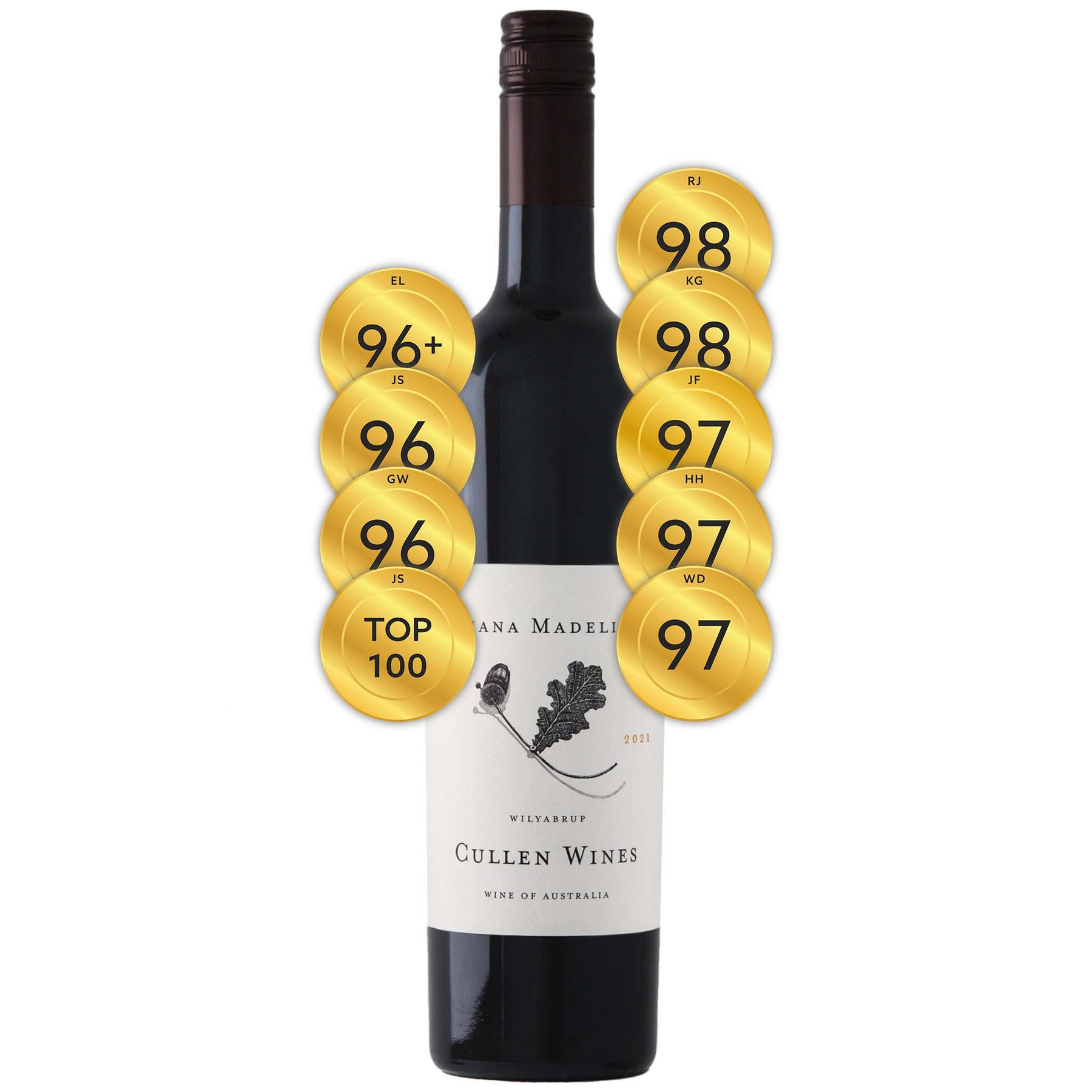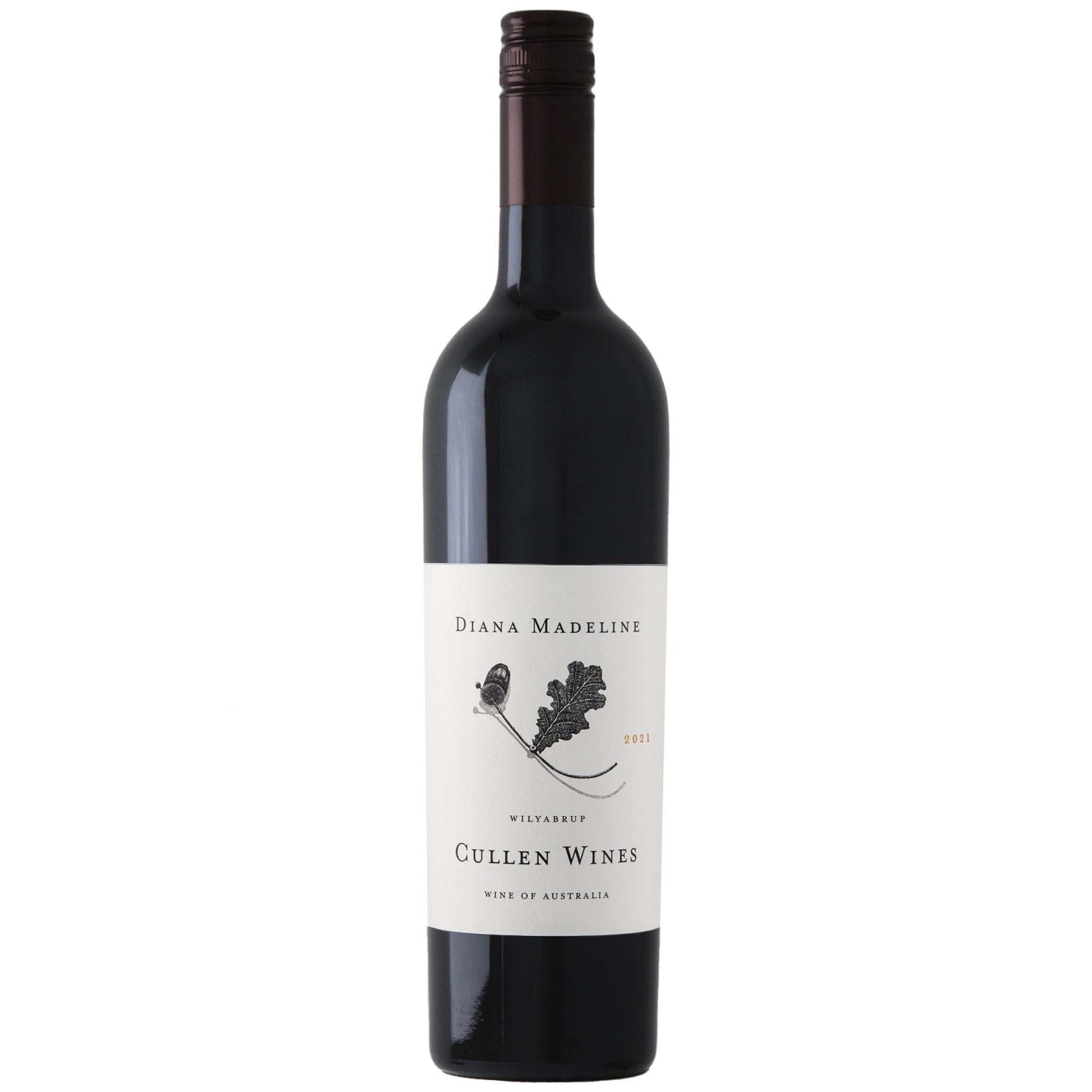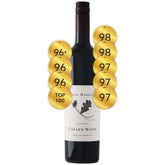

Cullen Diana Madeline 2021
Style: Red Wine
Closure: Screwcap
Cullen Diana Madeline 2021
Warehouse
34 Redland Drive
Vermont VIC 3133
Australia
Critic Score: 98
Alcohol: 13.5%
Size: 750 ml
Drink by: 2055
James Suckling Top 100 Wines of Australia 2022
"The first words I wrote at the Cape Mentelle International Cabernet Sauvignon tasting this year were – having just tasted the first wine and the first wine only – "well, job done, I’ve just tasted the wine of the day." It was a blind tasting of twenty Cabernet Sauvignons from around the world and while there would no doubt be many other stellar wines among them, this first wine was so emphatically good that I doubted that it would or could be topped. It turned out, when the identity of all the wines was later revealed, that this first wine was Cullen Diana Madeline Cabernet Sauvignon 2021. This emperor is fully clothed." Campbell Mattinson
Cullen is an iconic Margaret River winery and the Diana Madeline is their flagship red wine. It is famed for its quality and consistency, is sought after by collectors world-wide and is a worthy regional benchmark. It is a classic Cabernet Sauvignon dominant Bordeaux blend grown on an exemplary vineyard. The Cullen vineyard has been certified both Organic and Biodynamic since 2004.
"Wonderful fragrance of red and blue fruits, violets and subtle herbal notes, the palate is very full bodied and loaded with tannins, a big wine of awesome concentration and arresting structure, with terrific drive and power. Long, long finish. It's just a babe and has a big future. This really has some wow factor." Huon Hooke
Expert reviews
"This is a triumph for the vineyard in what was a challenging year in Margaret River. Low yields, birds and rain events all conspired to make things tough, but a rigorous biodynamic approach in the vineyard and later in the winery has resulted in a magnificent expression of a slightly cooler climate Margaret River Cabernet. High end florals on the nose with notes of violet and red berry overpaying the deeper blackcurrant concentration. The oak is well managed and integrated with the tannins firm and chalky providing the structure to support extended ageing. A worthy commemoration of family matriarch Diana Cullen who would have been 100 this year. Drink: 2023-2053." Ray Jordan, Wine Pilot – 98 points
"The newly released DM Cabernet is a particularly auspicious one, celebrating what would have been the 100th birthday of Diana Madeline herself. No doubt, she would have been delighted with the wine. In fact, it is very hard to remember when this Cabernet would not have been amongst the very best released in this country. This latest release is likely to be seen as one of the finest they have ever made. This is not just a great Margaret River wine, it is a great wine.
Deep opaque purple hue. The nose is a whirling dervish of spices, cherries, tobacco leaves, cassis, black fruits, leather and dried herbs with hints of cloves and blackberries. The structure is immaculate while the wine is focused, with the intensity maintained the full length to a very long finish supported by silky tannins. Certainly young now, and although it really is enjoyable, expect this wine to give great pleasure over the next two decades. It is going to get even better. This will surely be one of the top wines of the year, even at this early stage." Ken Gargett, Wine Pilot - 98 points
"The first words I wrote at the Cape Mentelle International Cabernet Sauvignon tasting this year were – having just tasted the first wine and the first wine only – "well, job done, I’ve just tasted the wine of the day." It was a blind tasting of twenty Cabernet Sauvignons from around the world and while there would no doubt be many other stellar wines among them, this first wine was so emphatically good that I doubted that it would or could be topped. It turned out, when the identity of all the wines was later revealed, that this first wine was Cullen Diana Madeline Cabernet Sauvignon 2021. This emperor is fully clothed.
Gumleaf and blackcurrant. Gravelly top notes. Firm tannin. Such command. Pencil shavings and cocoa. This is the cabernet brief, nailed. There’s flavour to the acidity. There’s firm, muscular power. There’s joy, flesh, freshness and silk.” Campbell Mattinson
"Diana Madeline. The name evokes a lot of emotions, for what the woman stood for then and what the wine stands for now. The 2021 vintage equals 50 years of cabernet sauvignon plantings at Cullen. When released in early 2023, it was on what would have been her 100th birthday. It's a wine that can come from nowhere else, so strong is its sense of place. Expect to swoon over aromas of roses, violets and mulberries doused in baking spices, a ferruginous quality as much as detailed if persuasive tannins. It's complex, complete and structured. Gosh, what a wine. What a woman. The perfect combination. Drink by 2045." Jane Faulkner, Halliday Wine Companion - 97 points
"Very deep, bright purple-red colour; wonderful fragrance of red and blue fruits, violets and subtle herbal notes, the palate is very full bodied and loaded with tannins, a big wine of awesome concentration and arresting structure, with terrific drive and power. Long, long finish. It's just a babe and has a big future. This really has some wow factor. Drink: 2026–2051." Huon Hooke, The Real Review - 97 points
"There is pressure on a winemaking team every time they craft an icon wine. For Vanya Cullen and her team in Margaret River there was even more pressure than usual when they put together the 2021 Cullen Diana Madeline, a Margaret River flagship. The 2021 Diana Madeline, named in honour of the co-founder of Cullen and Vanya's mum, will be released on February 11 - which would have been the 100th birthday of Diana Madeline. The new release is, fortunately for all concerned, a wine worthy of the occasion; complex but cohesive. As always, the 2021 Diana Madeline was picked according to the biodynamic calendar. It is a blend of 91% caberner sauvignon, 4% merlot, 4% cabernet franc and 2% malbec that was matured for 15 months in 50% new French oak. It is an assertive wine with dark plum and blackcurrant fruit notes to the fore, but is pleasingly restrained in the Bordeaux tradition at just 13.5% alcohol." Winsor Dobbin, gourmetontheroad.com – 97 points
"The 2021 Diana Madeline is composed of Cabernet Sauvignon (91%), Merlot (4%), Cabernet Franc (3%) and Malbec (2%). The only other time since the first 1995 vintage of this wine (formerly labeled as the Cabernet Merlot) that the percentage of Cabernet Sauvignon has crested 90% or higher was the 2016 vintage, which saw 93% Cabernet Sauvignon. The 2021 vintage in Margaret River was an interesting one, with several climate curveballs thrown at viticulturists during key times during the harvest season. Here, the fruit was handpicked on biodynamic fruit and flower days across five picks from the middle of March to the Super Moon flower day two weeks later. The wine was matured in French oak for 15 months (50% new). This 2021 is a lean, mineral rendition of the Diana Madeline, with bay leaf, rose petals, cassis, bramble and black tea forming layers that settle in the mouth. The tannins are grippy and very fine, causing one to chew slightly as one drinks. This is ethereal, as these wines often are, yet with line and length that belies its pretty curves and textures. The perfect, ideal apogee for this wine's drinking window is in the future. Get it while you can. Drink: 2024 - 2039." Erin Larkin, Wine Advocate - 96+ points
"A nose of blackcurrant, tobacco leaf, graphite and moss. Medium- to full-bodied with chewy, structured tannins. Linear onto the palate with an array of black fruit and savory herbs. Oolong and bark. Lovely balance and depth. A bit closed at the moment but will open and expand with some age. 91% cabernet sauvignon, 4% merlot, 3% cabernet franc and 2% malbec. From biodynamically grown grapes. Best after 2025." James Suckling, JamesSuckling.com - 96 points and Top 100 Wines of Australia 2022
"91% Cabernet Sauvignon, 4% Merlot, 3% Cabernet Franc & 2% Malbec. 50% new oak. Vines now 50 years old. Cherry, plum, dark chocolate, dried rose, lead pencil, baking spice. It's medium-bodied, saline and distinctly 'mineral' with a ferrous quality, crushed slate tannin, spice, I'm thinking Davidson plum?, with that hint of tartness, a musky perfume, so much energy, combining light and shade, and a long gently chewy tannic finish. Distinctive wine stamped firmly with a sense of place. Drink: 2025 - 2040+." Gary Walsh, The Wine Front - 96 points
Awards
James Suckling Top 100 Wines of Australia 2022
Organic/biodynamic

The combination of firstly organic, and subsequently biodynamic viticulture at Cullen Wines provides the opportunity for the land to exist at its full potential, thereby nurturing vines to produce their best and most individual grapes. Vanya Cullen has pushed the limits of biodynamic practices in every facet of the business and the yield of the estate vineyards has soared. All Cullen Wines are grown on a certified Biodynamic, Carbon Neutral and naturally powered estate.
Organic Viticulture
Since 1971 when the Cullen Vineyard was planted, chemical intervention was minimal and the family's concern for the environment paramount. In 1998 the change to total organic viticulture was made. Organics is about soil health and Diana and Vanya went intuitively towards healing the soil by putting back what had been taken out. Organic farming promotes biological activity, which converts plant and animal residue into stable humus. This in turn increases the soil's ability to retain moisture and provide a reserve of nutrients. The Cullen vineyards were certified A Grade Organic in 2003.
Biodynamic Viticulture
In 2003, whilst attending a Biodynamic Conference, Vanya Cullen decided that Biodynamics would add further to the holistic and natural approach to both vineyard and winemaking. Biodynamics builds on organic farming to make all organic processes work more efficiently and effectively.
Biodynamic viticulture is a philosophy combining the maintenance of sustainable soil fertility and the recognition of the link between plant growth and the rhythms of the cosmos. Moon rhythms strongly influence life on earth life. As tides rise and fall in a pulsing rhythm, so does the sap of plants and all other liquids including those within the earth's mantle. Viticultural practices are conducted according to these moon rhythms. The position of the moon in relation to the planets is critical in determining the optimal time to plant.
In addition, the difference between organic and biodynamic is the use of biodynamic preparations 500 and 501, with 502-508 also being used. Preparation 500 is cow horns filled with cow manure which helps the soil develop humus and attracts earthworms and micro organisms. Preparation 501 is cow horns filled with quartz crystals which aids photosynthesis and the uptake of minerals in the soil.
In 2004 the Cullen vineyards were certified A Grade Biodynamic.
About the winery

In 1948, Dr Kevin John Cullen and his wife Diana Madeline Cullen purchased their property in Wilyabrup, which is in the heart of Margaret River. In early 1965 they started considering other uses for their sheep and cattle farm. They decided to plant lupins, so invited Dr John Gladstones (who had studied lupins in his post-graduate research) to visit their property. Dr Gladstones had also put considerable work and research into the suitability of growing vines in southwestern Australia and, according to Diana, upon seeing their land said "Oh, you're mad growing cattle and sheep, why don't you grow grapes?"
Dr Gladstones described Wilyabrup as being the sweet spot of the Margaret River region, most favourable for growing Cabernet Sauvignon. In 1966 he published his now-famous report which compared the climate and soils of Margaret River to that of Bordeaux. Many regard him as the founder of the Margaret River wine region.
In 1971 Kevin and Diana Cullen made the decision to plant 18 acres of vines on the land, including their first Cabernet Sauvignon vines. Further plantings were made over the subsequent decades. The mature 28-hectare dry grown vineyard still operates today and the grapes for all the Cullen wines are sourced from here and the adjacent Mangan Vineyard which was planted in 1995.
While Kevin Cullen worked as a doctor to support the business, Diana Cullen supervised and managed the winery and became Chief Winemaker in 1981. Diana made history in 1982 by being the first woman to win a trophy at the Perth Royal Show. Kevin passed away in 1994 and Diana in 2003, and the Cullen flagship wines are now named in their honour; the Kevin John Chardonnay and Diana Madeline Cabernet Sauvignon Merlot. Both Kevin and Diana have been awarded life membership with the Margaret River Wine Industry Association, and in 2003 the WA Wine Industry Association introduced the annual Diana Madeline Cullen Award for Outstanding Contribution by an Individual to the WA Wine Industry in her honour.
In 1983 Diana was joined by daughter Vanya Cullen, who took over the reign as Chief Winemaker in 1989 and was also appointed Managing Director in 1999. With Vanya at the helm, the quality of the wine is paramount and every step taken in the vineyard and in the winemaking is geared to that aim. The quality of Cullen Wines comes in the main from the vineyard - the wines can only be as good as the grapes. To realise the full potential of the vineyard, Vanya has embraced organic and biodynamic viticultural practices and the vineyards were certified A Grade Organic in 2003 and A Grade Biodynamic in 2004.
The process of making the wine involves handling the fruit as little and as gently as possible. Practices such as hand harvesting, minimal fruit transport, sorting of the fruit before crushing, minimal wine movement, minimal fining for the whites, no fining for the reds and minimal filtration are employed. The wines mostly make themselves, with little or no intervention; which means the use of indigenous yeast, no additions of any kind and minimal oak use and fining.
Vanya Cullen received the "Australian Winemaker of the Year" award from Gourmet Traveller Wine magazine in 2000 and was voted "Woman of the Year" by UK based wine magazine The Drinks Business in 2008, becoming the first Australian to receive the award. Vanya was also awarded Halliday Wine Companion's winemaker of the year in 2020.
Cullen became the first vineyard and winery in Australia to be certified carbon positive, starting the process in 2006. Vanya Cullen is also on the board of the "Days of Change" program, which aims to help Western Australian people and businesses live and operate in a more sustainable way.
2021 marked a half-century for the brand and with it a celebration of the Cullen Wines legacy. "This year we celebrate 50 years of Cullen Wines – 50 years of sustainable wine growing preceded by 65,000 years of Wadandi sustainable land care," says Vanya. "Over that time we've been supported by generous people with a wonderful spirit of camaraderie and warmth of spirit, and we are so grateful."


Western Australia
Western Australia is home to more than 400 wineries across nine vast and extraordinary wine regions which are almost entirely concentrated in the south-west and great southern land divisions of the State. The regions are Blackwood Valley, Geographe, Great Southern, Peel, Pemberton, Manjimup, Margaret River and Swan District.
The oldest region is the Swan Valley, the best known both nationally and internationally is Margaret River and the largest is Great Southern. The Great Southern region is further divided into the five subregions of Albany, Denmark, Frankland River, Mount Barker and Porongurup.
The history of wine production in Western Australia dates back to 1840 with the establishment of Sandalford in the Swan Valley region. The recognition of the fine wine possibilities started to be realised after the establishment of the Margaret River Region in 1967, which has become renowned for its high quality Chardonnay and Cabernet Sauvignon. The other regions produce a diverse range of regionally distinct wines, from stunning Rieslings and evocative Shiraz, to a range of unique Cabernet Sauvignon blends.



